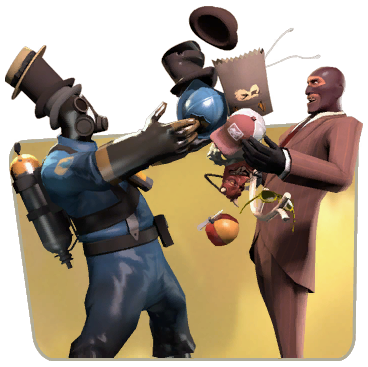
Featured Blog | This community-written post highlights the best of what the game industry has to offer. Read more like it on the Game Developer Blogs.
The Most Dangerous Game (Sometimes): Arbitrage in Team Fortress 2
This was my final essay for CTIN 190: Introduction to Interactive Entertainment in Spring 2015. This paper focuses on the various methods of microtransactions in the video game Team Fortress 2, and was originally submitted for a grade in May 2015.

 “Here. Buy yourself some talent.” - (The Spy, “Buy a Life,” 2014) (Fig. 1).
“Here. Buy yourself some talent.” - (The Spy, “Buy a Life,” 2014) (Fig. 1).
Microtransactions are in-game purchases of virtual items with real money after buying or downloading a videogame for free. In other words, the term almost no gamer wants to hear. Yet, they influence hundreds of gaming communities: from Gaia Online to Counter-Strike, microtransactions lie at the crux of contemporary gaming. Originally proposed in the 1990s, systems of microtransactions failed to spread until the 2010s, when developers revised their business models. 92 percent of revenue generated on Android and iOS games in 2013 came from this method of consumerism (Johnson, 2014). Developers advertise their applications as free, and then leverage a profit through in-game or in-app purchases. However, the use of microtransactions in virtual economies such as that of Valve’s online shooter Team Fortress 2 has turned into a game itself: those willing to gamble their items via arbitrage intend to, ideally, profit with very little risk involved.
“Everything you have is bad, compared to this thing!” (The Heavy, “Trading,” 2011).
Oxford Dictionary defines arbitrage as “the simultaneous buying and selling of securities, currency, or commodities in different markets or in derivative forms in order to take advantage of differing prices for the same asset” (“Arbitrage,” 2015). In other words, looking at the same item on two different markets, buying it on the cheaper market, then usually immediately selling it on the platform where it has a higher value. The Steam Community Market runs on this system, which differs from the Mann Co. Store, an in-game market with prices regulated by Valve. For simplicity’s sake, the rest of this essay will discuss, for the most part, the community side of TF2’s economics.
Before TF2’s Mann-Conomy Update, no trade system nor store existed within Team Fortress 2, leaving players to create random and class-specific—only wearable by certain playable characters—items by breaking down already-owned weapons of their choice into refined metal, then combining 3 refined metal into hats, random and class-specific items costing 54 and 75 smelted items respectively (“Crafting,” 2015). This frustrated many players, because they never had an absolute guarantee of what hat they would end up crafting, class-specific or not, and if they wanted to try crafting the resulting item to get something else, that required even more items. While the number of items required to craft hats and weapons remains the same, players usually decide to purchase those items instead of leaving things to chance.

When the Mann-Conomy Update arrived in September 2010, crates and keys made their in-store debut along with “Unusual” items appearing randomly when players unboxed crates. Keys, Unusual items, and crates differ from other items in that players do not have the ability to craft them. Items marked as Unusual, originally 14 available special effects attached to hats, have aptly retained approximately a one percent chance of being unboxed (“Unusual,” 2015) (Fig. 2, 2012). With the Mann-Conomy Update began the clamor for crates and bulk-buying of keys, the naming of TF2 keys as one of the ten most dubious in-game purchases available today (Livingston), and the mass inadvertent quoting of Tom Jones’s hit song “It’s Not Unusual.”
Despite the staggeringly low probability of Unusual items spawning, one of my friends spent about $187 USD on keys and managed to uncrate one Unusual item from the 75 crates he unboxed. As an arbitrageur, he purchased crates for an average of $0.03 USD on the community market, then unboxed them with the keys bought at full price.

Since the implementation of the Mann-Conomy, metal has lost its original function as a part of a recipe, now utilized as currency in player-to-player trading (“The Coming Economic Crash,” para. 13, 2014). Contrary to popular belief, TF2 key prices actually stabilize during game and content updates because players attempt to craft the items released in those updates using their already-existent metal or by breaking down unwanted items into metal, thus resurrecting its use as a component and not just a de facto currency (“The Coming Economic Crash,” para. 14, 2014). As a result, the value of metal inversely correlates with the amount of keys in circulation, which currently stands at an estimated 274,175 (“TF2 Item Statistics,” 2015). In addition, game updates and content releases allow for an increase in arbitrage potential as seen in the graph to the right, where peak moments represent a large amount of potential for trading to occur between players while the thicker lines delineate the actual volume of transactions taking place (Fig. 3). A close friend of mine bartered a copy of Sid Meier’s Civilization V for a mere 4 keys—a little under $12.04 CAD ($10 USD)—and she later acquired the game’s downloadable content for 2 keys. Had she instead chosen to purchase a retail or digital copy of the full game, she would have had to pay $60.51 CAD ($49.99 USD).
As pointed out in economist Yanis Varoufakis’s  article on arbitrage in TF2, this system of economics functions extraordinarily well despite the fact that it relies on the necessity of a double coincidence of wants, meaning traders must be willing to receive a certain item in exchange for a specific quantity of another currency or items (“Arbitrage and Equilibrium,” para. 4, 2012) (Fig. 4, 2014). For example, if Player X wanted to trade a hat for 5 keys, Player Y would have to agree to trade away that amount of keys in order to acquire that specific hat, and Player X would have to accept 5 keys (approximately $12.45) as payment for trading their hat. From personal experience, I can say that it is quite common for people to try to trick less-experienced players into trading a high-value item for very little in return: too many times have players asked for my Earbuds—a limited edition promotional item only available to TF2 Mac OS X users from June 10, 2010, to August 16, 2010—for as little as 2 keys. Luckily, price checking sites such as the TF2 Price Calculator can provide prospective buyers and sellers with accurate prices of items based on the current volume of trades taking place and the average values within, reducing the probability of scamming or imbalanced offers so long as players actually look at these sites immediately before accepting their trade offers (Fig. 5, 2015).
article on arbitrage in TF2, this system of economics functions extraordinarily well despite the fact that it relies on the necessity of a double coincidence of wants, meaning traders must be willing to receive a certain item in exchange for a specific quantity of another currency or items (“Arbitrage and Equilibrium,” para. 4, 2012) (Fig. 4, 2014). For example, if Player X wanted to trade a hat for 5 keys, Player Y would have to agree to trade away that amount of keys in order to acquire that specific hat, and Player X would have to accept 5 keys (approximately $12.45) as payment for trading their hat. From personal experience, I can say that it is quite common for people to try to trick less-experienced players into trading a high-value item for very little in return: too many times have players asked for my Earbuds—a limited edition promotional item only available to TF2 Mac OS X users from June 10, 2010, to August 16, 2010—for as little as 2 keys. Luckily, price checking sites such as the TF2 Price Calculator can provide prospective buyers and sellers with accurate prices of items based on the current volume of trades taking place and the average values within, reducing the probability of scamming or imbalanced offers so long as players actually look at these sites immediately before accepting their trade offers (Fig. 5, 2015).

However, like all systems of economics, this one does not exist without its flaws. A system of community-based arbitrage can easily lead to hyperinflation under certain circumstances, as it has now. Since the conclusion of the game’s June 2014 Love and War Update—which temporarily stabilized key prices due to an increase in metal’s use in crafting—people have made a habit of buying up keys en masse in reaction to the prices of them increasing, lowering the buying power of metal and exacerbating the fall of the price of Earbuds (“The Coming Economic Crash,” para. 14, 2014). As I type this, keys have now  hit the value of 20 refined metal, $0.12, or 0.23 Earbuds. When I started writing this essay, they cost around 18 refined metal. And now they have gone back down to 19. Capriciousness aside, we can unpack this issue further by taking a look at the number of TF2 players currently in existence and active (Fig. 6, 2013). Records indicate that users’ concurrency and frequency of playing skyrocketed when the game became free-to-play in June 2011, then plunged back down within the next 90 days (“Summary of Various Reasons,” 2013). When Valve enabled Steam Trading, more users became active, and each instance of new content added to the game since has shown temporary jumps in concurrency that then subside after the end of each update.
hit the value of 20 refined metal, $0.12, or 0.23 Earbuds. When I started writing this essay, they cost around 18 refined metal. And now they have gone back down to 19. Capriciousness aside, we can unpack this issue further by taking a look at the number of TF2 players currently in existence and active (Fig. 6, 2013). Records indicate that users’ concurrency and frequency of playing skyrocketed when the game became free-to-play in June 2011, then plunged back down within the next 90 days (“Summary of Various Reasons,” 2013). When Valve enabled Steam Trading, more users became active, and each instance of new content added to the game since has shown temporary jumps in concurrency that then subside after the end of each update.

With more users joining, players desire the best items and to have the most buying power in the market. As such, this increases the probability of players creating idle accounts for the express purpose of attaining more playtime and items, and therefore further opportunities to smelt those commodities into metal. Although TF2 ensures that players will find items at intervals between 30 to 70 minutes of playtime, Valve has placed a ten-hour limit on how many item drops can occur per user, per week in order to prevent the abuse of idling, resetting the cap every Thursday at midnight GMT (Fig. 7, 2011). Even so, if 100 idle users maximized their ability to acquire as many items as possible, they would, in total, need 1680 idling accounts, given each account has a weekly item drop limit of 10 hours  per week per account, and each week has 168 hours (“Summary of Various Reasons,” para. 2, 2013). Some users own over 500 idling accounts that they can easily automate with the right software (“Advanced Mann-Conomy”, 2011) (Fig. 8, 2011). In the end, idle account owners can smelt the items they do not want into refined metal, then buy up as many keys as they can afford thereafter. Though frowned upon, this rogue practice does, in fact, play a large role in determining the buying power of metal, given idle account owners have more instances of play simultaneously and by extension more inventory room to hold the items they can acquire and craft during those instances.
per week per account, and each week has 168 hours (“Summary of Various Reasons,” para. 2, 2013). Some users own over 500 idling accounts that they can easily automate with the right software (“Advanced Mann-Conomy”, 2011) (Fig. 8, 2011). In the end, idle account owners can smelt the items they do not want into refined metal, then buy up as many keys as they can afford thereafter. Though frowned upon, this rogue practice does, in fact, play a large role in determining the buying power of metal, given idle account owners have more instances of play simultaneously and by extension more inventory room to hold the items they can acquire and craft during those instances.
Gifting diverges from typical trading in the TF2 economy, yet still plays an important role in its gamification and social capital: it facilitates the exchange of virtual gifts without wants actually having to factor into the equation. Around mid-December, the rate of gift-giving between Steam users rises exponentially due to the occurrence of various holidays such as Chanukah, Christmas, Boxing Day, and Kwanzaa (Fig. 9, 2011). More often than not, these typically one-sided transactions do not require a double coincidence of wants, differentiating them from arbitrage (Varoufakis, 2012). A variety of factors cause gift-giving to divert from simple trading: the intersection of gaming and real-life communities, friend lists, and other commonalities between players all affect the willingness of one person to give something sufficiently valuable to another per their relationship. Because one cannot accurately quantify the value of relationships between two players in relation to gift-giving, let alone the  millions that trade online every day, the prices within gift-based trades prove unreliable due to the unpredictability of players’ generousness. However, although a player may thoroughly enjoy the gifts they receive, they could very easily sell, trade, or even gift duplicate goods or other commodities that they do not want in order to acquire items that they hope to own. Despite that, unlike the previously mentioned forms of acquiring items, the social dynamics of gifting are primarily based on compassion and pure exchanges rather than a coincidence of wants.
millions that trade online every day, the prices within gift-based trades prove unreliable due to the unpredictability of players’ generousness. However, although a player may thoroughly enjoy the gifts they receive, they could very easily sell, trade, or even gift duplicate goods or other commodities that they do not want in order to acquire items that they hope to own. Despite that, unlike the previously mentioned forms of acquiring items, the social dynamics of gifting are primarily based on compassion and pure exchanges rather than a coincidence of wants.
Trading in Team Fortress 2 has become a game of wits in and of itself; one can profit through several various methods of trade from arbitrage to creating alternate accounts. Although the prices of metal and keys fluctuate constantly, players continue to act upon the opportunities for profit given to them through arbitrage while accepting the fact that the items they procure could potentially fall in value at any time. The various methods of exchanging items all factor into the economy’s ability to function, and therefore it cannot truly exist as it does today without them. Gamers may not want to deal with microtransactions, but developers will probably not get rid of them in the near future, and arbitrage will most likely remain inTF2 for the rest of its shelf life. Free-to-play games such as this one rely on the hypothesis that players will pay for virtual goods in small increments because they desire instantaneousness immersion, and not everyone may have the means to buy a $60 game. As shown through idle accounts, general trading, and gifting, players will go far to achieve what they want, even if it means risking a few extra cents in that moment.
References
Advanced Mann-Conomy: How to Idle With Multiple Accounts. (2011, December 22). Retrieved
May 2, 2015, from http://facepunch.com/showthread.php?t=1102531
Buy a Life [Digital]. (2014). Retrieved April 29, 2015, from https://
wiki.teamfortress.com/wiki/File:Taunt_Buy_A_Life.png
Concurrent Active Players [Graph]. (2013). Retrieved 2 May, 2015, from http://
tf2finance.com/2013_03/2.png
Item Drops Graph [Graph]. (2015). Retrieved April 30, 2015, from https://
wiki.teamfortress.com/wiki/File:Item_drops_graph.png
Item Drop System. (2015, February 12). Retrieved May 2, 2015.
Johnson, E. (2014, April 14). Some Gamers Fear a Dystopian Free-to-Play Future. Retrieved 4
May, 2015, from http://recode.net/2014/04/14/some-gamers-fear-a-dystopian-free-to-
play-future/
Livingston, C. (2015, January 7). Micro-infractions: The 10 Most Dubious In-game Purchases.
Retrieved May 2, 2015, from http://pcgamer.com/the-worst-microtransactions/
M.A.I.D. Screenshot [Digital]. (2011). Retrieved May 2, 2015, from
http://i.imgur.com/gAVU8.jpg
Secret Saxton [Digital]. (2015). Retrieved 4 May, 2015, from http://puu.sh/hCblw/
54b0fd91d2.png
Steam Trading [Digital]. (2015). Retrieved May 2, 2015, from https://wiki.teamfortress.com/w/
images/d/d5/Steam_trading.png?t=20110907174055.
TF2 Calculator [Calculator]. (2015). Retrieved May 4, 2015, from http://puu.sh/hBAMl/
1792b73e14.png
TF2 Item Statistics: Compiled from All Possible Public Backpacks 2012. (2012, May 23).
Retrieved May 3, 2015, from http://stats.tf2finance.com/
TF2 Trading Analysis (Mar 2013): Summary of Various Reasons for the Increase in Key Prices.
(2013, March 18). Retrieved May 3, 2015, from http://tf2finance.com/2013_03/
TF2 Unusual Unbox Rate. (2013, March 18). Retrieved May 5, 2015, from
http://tf2finance.com/rate/
TF2 Unusual Unbox Rate [Formula]. (2013). Retrieved April 30, 2015 from http://
tf2finance.com/rate/formula.png
The Coming Economic Crash and How to Survive. (2014, November 2). Retrieved May 3, 2015,
from http://steamcommunity.com/sharedfiles/filedetails/?id=333389464&insideModal=1
Varoufakis, Y. (2012, June 22). ARBITRAGE AND EQUILIBRIUM IN THE TEAM
FORTRESS 2 ECONOMY |
Valve. Retrieved May 1, 2015, from http://blogs.valvesoftware.com/economics/arbitrage-
and-equilibrium-in-the-team-fortress-2-economy/
Varoufakis, Y. (Economist). (2012). Arbitrage As Never Seen Before [Graph]. Retrieved April 30,
2015, from https://varoufakis.files.wordpress.com/2014/05/screen-shot-2014-05-07-
at-7-00-09-pm.png
Varoufakis, Y. (2012, July 1). TO TRUCK, BARTER AND EXCHANGE? On the nature of our digital
economies | Valve. Retrieved May 1, 2015, from http://blogs.valvesoftware.com/
economics/to-truck-barter-and-exchange-on-the-nature-of-valves-social-economies/
Welcome to TF2 Calculator! (2013, January 1). Retrieved May 2, 2015.
Read more about:
Featured BlogsAbout the Author(s)
You May Also Like













